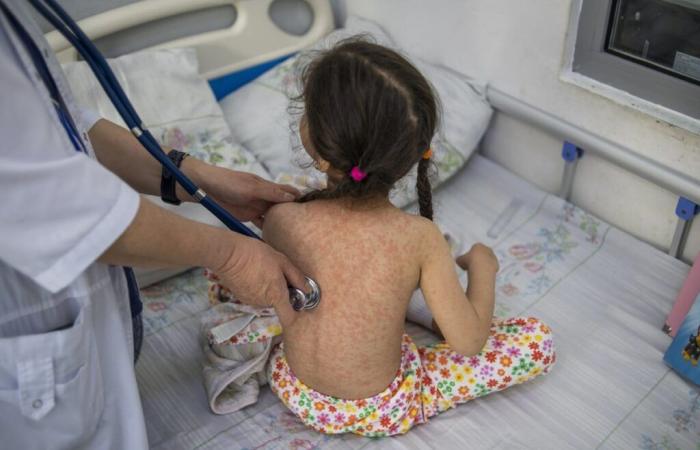Worldwide, there will be an estimated 10.3 million cases of measles in 2023, an increase of 20% from 2022, according to new estimates from the World Health Organization (WHO) and the Centers for United States Diseases Control and Prevention (CDC). Insufficient vaccination coverage globally is behind the increase in the number of cases.
Two doses of measles vaccine prevent illness; yet, by 2023, more than 22 million children have not received their first dose of vaccine. Globally, it is estimated that last year, 83% of children received their first dose of measles-containing vaccine, while only 74% received the recommended second dose.
A minimum of 95% coverage with two doses of measles vaccine is needed in every country and community to prevent outbreaks and protect populations against one of the world’s most contagious human viruses.
“The measles vaccine has saved more lives than any other vaccine in the last 50 years,” said Dr.r Tedros Adhanom Ghebreyesus, Director-General of WHO. “To save even more lives and prevent this deadly virus from harming the most vulnerable, we must invest in vaccinating every person, no matter where they live. »
“The number of cases of measles virus infection is increasing around the world, compromising population health and putting lives at risk,” said CDC Director Dr.re Mandy Cohen. “The measles vaccine is our best protection against this virus, and we must continue to invest in efforts to expand access to it.”
Due to gaps in vaccination coverage globally, 57 countries experienced significant or disruptive measles outbreaks in 2023, a number up almost 60% from 36 countries the previous year, all Affected regions except the Americas. The WHO Africa, South-East Asia, Europe, Eastern Mediterranean and Western Pacific Regions have seen a sharp increase in the number of cases. Nearly half of all large or disruptive outbreaks have occurred in the African Region.
Unacceptable number of deaths due to increase in measles cases
The new data shows that around 107,500 people, mainly children under the age of 5, died from measles in 2023. Although this is an 8% decrease from the previous year, far too many children are still dying from this preventable disease. This slight reduction in deaths is mainly because the increase in cases occurred in countries and regions where children with measles are less likely to die, due to better nutritional status. and better access to health services.
Even when people survive measles, the disease can cause serious health effects, some of which persist for life. Infants and young children are most at risk of serious complications from the disease, which include blindness, pneumonia, and encephalitis (an infection causing inflammation of the brain and potentially brain damage).
As measles cases rise and outbreaks increase, the goal of eliminating the disease globally, as set out in the 2030 Agenda for Immunization, is under threat . By the end of 2023, 82 countries had achieved or maintained measles elimination. This week, Brazil was confirmed to have achieved this again, making the WHO Region of the Americas once again free of endemic measles. With the exception of the African Region, at least one country in all WHO Regions has eliminated the disease.
Urgent and targeted efforts by countries and partners, particularly in the Africa and Eastern Mediterranean Regions, and in contexts of fragility, conflict and vulnerability, are needed to fully vaccinate all children with two doses of measles vaccine. To do this, it is necessary to sustainably implement effective systematic vaccination programs and carry out quality campaigns to achieve high coverage when these programs are not yet sufficient to protect each child.
Countries and global immunization partners also need to strengthen disease surveillance, including the WHO Global Measles and Rubella Laboratory Network (GMRLN). Rigorous disease surveillance is essential to optimize immunization programs, detect and respond quickly to measles outbreaks to mitigate their scale and impact.
Note to editors
The report entitled Global progress towards measles elimination, 2000-2023, is a joint WHO-CDC publication appearing in the WHO Weekly Epidemiological Report and the CDC Morbidity and Mortality Weekly Report. The CDC and WHO use statistical modeling to estimate measles cases and deaths each year, based on cases reported by countries, and revise estimates from the previous year to assess disease trends over time.
CDC and WHO are founding members of the Measles and Rubella Partnership, a global initiative to end both diseases. As part of the 2030 Agenda for Immunization, the mission of the Measles and Rubella Partnership, which also follows the guidelines of the 2030 measles and rubella strategic framework, consists in particular of combating the decline national vaccination coverage, accelerate catch-up from the decline in protection against measles resulting from the COVID-19 pandemic, and progress more quickly towards a world free of measles and rubella. The American Red Cross, the Bill & Melinda Gates Foundation, the Gavi Alliance, the United Nations Foundation and UNICEF are also members of the Partnership.
Measles elimination is defined as the absence of endemic transmission of measles virus in a given region or geographic area for more than 12 months. Conversely, a country is no longer considered measles-free if the virus returns and transmission continues continuously for more than a year.
For more information about CDC’s global measles vaccination efforts, visit: https://www.cdc.gov/global-measles-vaccination.
For more information on WHO’s action and support on measles, visit: https://www.who.int/en/news-room/fact-sheets/detail/measles .






